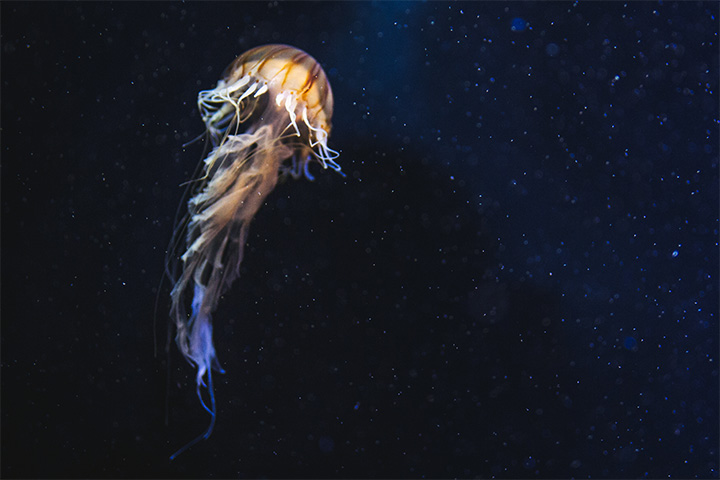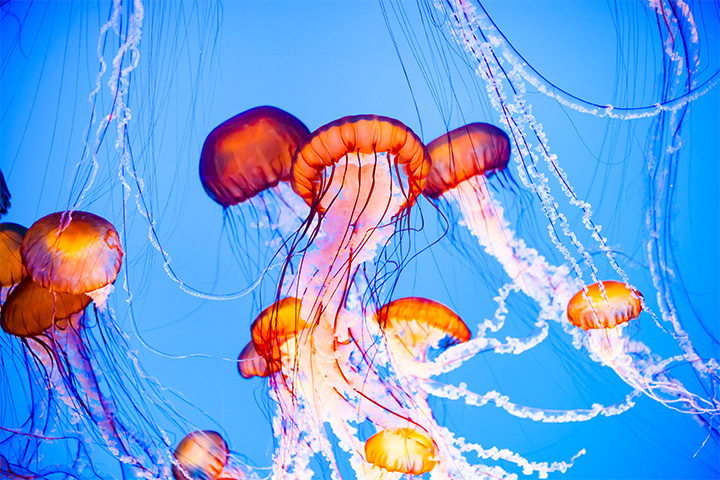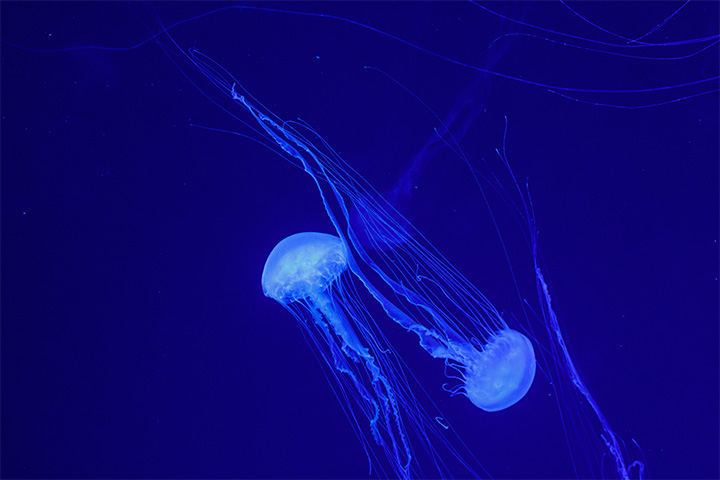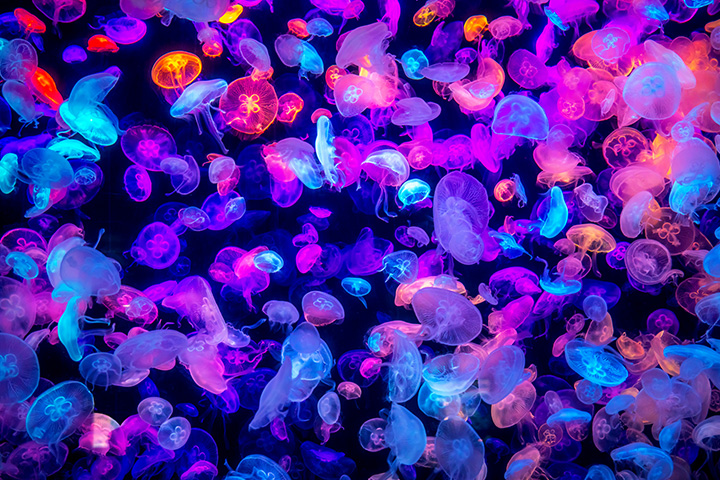
Image: ShutterStock
Facts about jellyfish for kids will surely delight them as they are one of the coolest and most beautiful looking sea creatures. This water creature is scary, but there is plenty of interesting information surrounding a jellyfish that makes it quite the exotic sea creature that it is. It has lived for millions of years on this planet; therefore, its survival tactics are a matter of study among enthusiastic underwater biologists as well. To help your kids learn a few cool facts about a fascinating sea creature like jellyfish, we bring you a roundup of fun facts about jellyfish. Scroll down.
Information About Jellyfish For Kids
1. Scientific Classification Of Jellyfish:
The jellyfish are grouped under CnidariaphylumiXA taxonomic rank used to classify organisms with similar body plans, developmental patterns, and/or evolutionary histories,其特征是存在的a gelatinous and a non-living body embedded between the epithelial layers.There are around 2000 different types of jellyfish and scientists say that 3000000 different species of jellies are yet to be discovered.
2. Jellyfish Are Not Actually Fish:
Yes, that’s right! Jellyfish are not fish. They are plankton from the phylum Cnidarian and Scyphozoan class. Most people consider the term a misnomer. The American public aquariums have given the termsea jelliesor jellies instead.
3. The Anatomy Of A Jellyfish:
Jellyfish come in a diverse range of forms and colors like pink, white, yellow, orange, green, and blue. Some are even multi-colored. Jellyfish are composed of 90% water. Most of their body is a gelatinous material called mesoglea surrounded by two layers of cells that form the umbrella. The subumbrella of the body is called the bell.
Jellyfish do not have arespiratory system, as their skin is thin enough to oxygenate the body by diffusion.Neither do they have a central nervous system or brain. Rather, they have a loose network of nerves (nerve net) located in the epidermis. This nerve net helps them sense the changes in their environment and coordinate the marine animal’s responses.
The mouth of the jellyfish is housed in a dome or bell-shaped central body area surrounded by tentacles. They discard and eat the waste from this mouth-like opening. They even squirt water from their mouth, which propels them forwards.
4. Jellyfish Locomotion:
The movement of jellyfish depends on the currents and tide of the water and wind. Some jellyfish are sensitive to light and move downwards during the daytime. Jellies also need water for survival. The absence of water can cause desiccation and these marine creatures can lose their life.
5. The Deadly Tentacles Of Jellyfish:
Image: IStock
Jellyfish have stinging cells in the tentacles, which are filled with toxins. They stun or immobilize their prey before eating them. Jellyfish typically don’t attack humans. Most of the stings occur when humans accidentally touch a jellyfish. But, some species of jellyfish can be menacing for humans. Jellyfish washed ashore can also sting. Be very careful if you are investigating a specimen. A tentacle separated from its body can sting and carries enough venom to be a threat to life.
 Quick tip
Quick tip6. Jellyfish Are Dioecious:
Jellyfish are dioecious. So a jellyfish colony will either be entirely female or male. And in most of cases, both male and female jellyfish release eggs and sperm into the surrounding water where the eggs fertilize and mature into new organisms.
7. The Deadliest And The Largest Jellyfish:
The box jellyfish is the deadliest animal in theanimal kingdom. It has caused 5568 deaths since 1954. Each tentacle of the box jellyfish has around 500000 cnidocytes, harpoon-shaped needles that inject venom into the victim. The venom can lead to a 4 to 10-year-old child’s death within 3 minutes.
北极t的狮子的鬃毛是最大的物种he jellyfish. The Arctic Lion’s Mane jellyfish is one of the longest known marine animals. The diameter of the body of Arctic Lion’s Mane is 7 feet 6 inches. And the tentacles are around 120 feet long. An Arctic Lion’s Mane was found washed up on the Massachusetts Bay shore in 1870.
8. The Humongous Portuguese Man-Of-Wars:
The Portuguese Man-of-Wars can grow up to 50 meters long. On a baseball diamond, these jellyfish would reach more than halfway to second and from home plate to first base. You’ll find these jellyfish mostly in groups, floating in warm ocean waters. To avoid the threats, Portuguese Man-of-Wars deflate their air bladder and sink briefly under the water.
9. The Smallest Jellyfish:
Creeping Jellyfish, belonging to the Staurocladia, is the smallest species of jellies. It has 0.5mm bells discs with tiny tentacles that stretch out a bit further. These jellies crawl at the base of the ocean, and you cannot see them without a hand lens or microscope.
10.水母正在增加在全球范围内:
Image: IStock
When the conditions are good, that is the perfect temperature and plenty of food, jellyfish can grow extremely fast and reach high numbers. It’s a part of the natural seasonal cycle of the jellyfish species.
But scientists also believe that we have more jellyfish than before because of the changes brought in the ocean. A combination of climate change, overfishing, nutrients, and the introduction of species could also be why jellyfish numbers have skyrocketed.Some scientists also say that jellyfish have increased because of coastal development, providing more underwater habitat for the jellyfish to grow.
11. What Do The Jellyfish Eat?
Jellyfish’s diet consists of different things like fish eggs,copepodsiXA group of small aquatic crustaceans found in freshwater and marine environments, shrimps, small plants, and other small fish called larvae. They eat the planktonic eggs at the younger stages. Some jellyfish also eat other jellyfish! When the jellyfish bloom, they eat almost everything in the water, which often causes problems for the fisheries because of the lack of food.
Jellyfish have a strong digestive system. They digest the food extremely fast. That’s because they wouldn’t be able to float if they carried digested meals around.
12. The Friendliest Jellyfish:
Moon Jellyfish is the friendliest species of jellyfish.These jellyfish also sting, but the effects are mild and short-term.
Moon Jellyfish is the most common species of jellyfish. You’ll find this species of jellyfish mostly in the aquariums. But since they are a minuscule species of jellyfish, they do not survive for more than six months in their natural habitat. The factors responsible for the death of Moon Jellyfish are warm temperature, lack of food and diseases. They live for several years in the controlled conditions of the aquariums, where there is no predator or competition for food.
13. Jellyfish As Food:
Non-poisonous jellyfish are considered a delicacy in many parts of the world. Around several hundred metric tons of jellyfish are eaten every year at $15 a pound, making it a multi-million dollar business. The Cannonball Jellyfish is the most commonly eaten jellyfish.
After being caught, a treatment procedure is continued for 20 to 40 days, during which the gonads and mucus lining are removed. The remaining edible parts are processed with alum and salt mixture. The result is crunchy and salty jellies.
The Chinese have been fishing it for over 17000 years for food and in Malaysia, people call them “music to the teeth.”
A group of students in Japan made a salted caramel dish using powdered jellyfish. Scientists say that it’s an excellent way to deal with the Jellyfish Bloom.
 Quick fact
Quick fact14. Jellyfish Are Great At Shutting Down Nuclear Reactors:
It has been reported that jellyfish blooms are responsible for shutting down nuclear reactors, most of which rely on ocean water intake.The swarms of the jellyfish clog intake pipes, forcing many facilities to cease operations temporarily.
15.水母的生命周期:
Image: Shutterstock
Just like most animals, even the jellyfish has a life cycle. Their reproduction process is known as the medusa stage where jellies swim around with their tentacles hanging down. Male and female medusa then reproduce and form thousands of tiny larvae called planulae. The larvae settle on the bottom of the ocean and form small polyps that look just like little small Anemone. The polyp buds off baby jellyfish called the ephyrae, which grow quickly into adult medusa.
16. Lifespan Of A Jellyfish:
The lifespan of jellies is 30 years. Some jellyfish live less than a year while the smallest one lives just for a few hours. The size and lifespan depend on the species. But on an average, most jellyfish live for 2 to 6 months.
 Did you know?
Did you know?17. Some Jellyfish Glow In The Dark:
Some of the jellies have the quality of bioluminescence, which means they make their light. They have bioluminescent organs that help them emit light. These jellies use this light to distract predators and attract prey.
18. Jellyfish Are Not Good Swimmers:
With no flippers or fins, jellyfish are weak swimmers. They swim by contracting the muscles at the bottom of their belly.
The upside-down jellyfish do not even float in the waters. Instead, they bring themselves to the ocean floor using their short arms and tentacles. They look more like a bowl of plants than typical jellyfish.
19. Intelligent Attackers:
Jellies do not chase or stalk their prey. Instead, they swim or drift with the tentacles dangling behind them. If a fish or other small creatures bump into the tentacles, it is zapped by the stingers. Then they use the oral arms to move the prey to the mouth.
20. The Secret Weapon:
Image: IStock
Along with the tentacles, jellies also have a secret weapon, that’s their oral arms and their tiny stinging cells called nematocysts. These cells contain little harpoons full of venom, which can do away with or stun the prey.
21. Not All Jellies Are Loners:
尽管大多数动物避免果冻,有些人喜欢hanging around with them. A few marine creatures use jellyfish as a kind of bodyguard. For instance, crabs are known to hitchhike on jellyfish. Some tag along for a ride inside its belly or just stay close to the jelly. There are different ideas why the tagalongs are unharmed by the jellies. Some researchers say that these tagalongs cover themselves with mucus to keep the stingers from firing. Or maybe they are just too careful not to touch the jelly’s tentacles.
22. Jellyfish Clone Themselves:
If you cut a jellyfish in two, these two pieces can regenerate and create two new organisms. It can clone itself, even when it is injured, thereby producing hundreds of offspring.
23. Jellyfish Teach Us About Efficient Underwater Propulsion:
The movement of the bell-shaped jellyfish has given researchers an understanding of propulsion. The flexibility of their umbrella-shaped bodies allows the jellyfish to move upwards and downwards without expending too much energy. Researchers have created abiomimeticiXThe designing of technology and materials that mimic natural systems, structures, and processes in living organisms for study purposesrobot with flexible bells, which can lead to better undersea vehicles.
24. Some Species Jellyfish Are Immortal:
There are two stages in the life of a jellyfish- the mobile medusa phase and stationary polyp stage. They earned the nickname ‘immortal jellyfish’ for its ability to travel to the polyp stage in times of stress.
25. Aggressive Colonizers:
Image: IStock
Jellyfish are very aggressive colonizers. When the Comb Jellies were introduced into the Black Sea in the year 1982, they totaled 900 million tons. Eight years after the introduction, they caused $350 million in losses to the Black Sea’s tourism and fishing industries
Fun Jellyfish Facts For Kids
- A group of jellyfish is called smack or bloom. A smack or bloom of jellyfish can consist of more than 100000 jellyfish.
- You must have noticed that jellyfish are mostly kept in round aquariums. That’s because round aquariums prevent them from getting stuck in the corners.
- If someone is stung by the jellyfish, pour vinegar over the wound and seek medical assistance as soon as possible.
 Did you know?
Did you know?- The movements of jellyfish inspired a flying machine at the New York University.
- Jellies’ fluorescent protein can be used to make power medical devices in the future.
- Common predators of the jellyfish are tuna, sharks, jellyfish,sea turtles, swordfish, and Pacific salmon.
- Jellyfish bloomsnear Japancan have around 500 million jellyfish, with each jelly the size of a refrigerator.
- Jellyfish account for over ten times the weight of the annual fishes caught around the world.
- Jellies have medicinal value too. They are harvested forcollageniXProtein that provides structural support and elasticity to connective tissues with its fiber-like structurethat is used in plenty of ways, including the treatment ofrheumatoid arthritisiXAn autoimmune disease that causes chronic inflammation of joints, causing pain and stiffness.
- Approximately, 160 million people are exposed to jellyfish annually all across the globe. And around 500000 people in the Chesapeake Bay and 200000 in Florida are stung each year
经常Asked Questions
1. Can jellyfish hear?
Jellyfish do not have ears and do not have a true hearing ability(1). However, jellyfish can detect underwater sounds and respond to them with the help of tiny hair-like sensors on their body(2).
2. How many hearts does a jellyfish have?
Jellyfish do nothave hearts(3). The reason is that they do not have a circulatory system. The nutrients, gasses, and wastes are exchanged with the ambient water through diffusion(4).
3. Can jellyfish survive without food?
朗水母会缩小自己生存ger without food. Those living in natural habitats seldom have food shortages since jellyfish have a wide appetite. They can eat almost anything, from tiny plankton to fish and even other jellyfish(5).
Knowing some facts about jellyfish for kids can be exciting since they are beautiful marine creatures. You may explain the scientific classification of jellyfish and their anatomy to your children. Jellyfish are not real fish and have deadly tentacles filled with toxins that can be injected while stinging. They move according to the tide of wind and water, and some may glow in the dark. Non-poisonous jellyfish are consumed in many parts of the world. Climate change and ocean changes increase the number of jellyfish, and these facts will get your child interested to know more about marine life.
Infographic: Fun Jellyfish Facts
Jellyfish are known to be among the captivating ocean-dwelling creatures. Although they may be seen in various shapes, jellyfishes have a characteristic umbrella-shaped bell and trailing tentacles. Scour through the infographic below for more exciting information about jellyfish; share them with your little ones to enhance their interest in these aquatic wonders.

Illustration: Momjunction Design Team
Get high-quality PDF version by clicking below.
Download Infographic
Key Pointers
- The jellyfish’s body is composed of 90% water and surrounded by two layers of cells that form the umbrella.
- A respiratory system or brain is absent in jellyfish, but they possess a nerve net that helps them sense changes in their environment.
- Jellyfish tentacles, filled with toxins, can be dangerous to humans.
- Jellyfish survive by capturing plankton and different marine creatures with their tentacles, which are filled with toxins capable of paralyzing their prey.
- Jellyfish can clone themselves and generate multiple offspring.
Learn all about jellyfish with this fun and educational video! Discover their anatomy, behavior, and more as we explore the fascinating world of jellyfish!
References:
- A stress test for jellyfish.
https://wyss.harvard.edu/news/a-stress-test-for-jellyfish/ - David J. Albert; (2010); What’s on the mind of a jellyfish? A review of behavioural observations on Aurelia sp. Jellyfish.
http://www.rctn.org/bruno/animal-eyes/jellyfish-papers/Neuroscience%20and%20Biobehavioral%20Reviews%202011%20Albert.pdf - Hearts, and the Heartless, in the Animal Kingdom.
https://kids.frontiersin.org/articles/10.3389/frym.2020.540440 - Overview of the Circulatory System.
https://opened。cuny.edu/courseware/lesson/813/student/?task=3 - Jellyfish And Comb Jellies.
https://ocean.si.edu/ocean-life/invertebrates/jellyfish-and-comb-jellies - Intra and Inter specific variation in edible jellyfish Biomarkers and implications for origin Traceability and authentication.
https://www.frontiersin.org/articles/10.3389/fmars.2021.755048/full - Five jaw dropping facts about jellyfish.
https://www.oneearth.org/five-jaw-dropping-facts-about-jellyfish/ - How to Treat and Prevent Jellyfish Stings.
https://www.chkd.org/blog/how-to-treat-and-prevent-jellyfish-stings/























